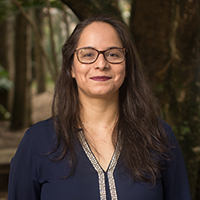Introduction
This course will provide you with the basis to understand the elements that constitute a language. What is a sound? What is a word? What about a phrase or a sentence? What is a text? What is discourse? These are the main questions that you will deal with throughout our time together.
It is not easy to try to explore these issues, but keep in mind that even experts argue about them, and that there is neither a definite nor a simple answer for most of these questions yet. So, it is certainly not the intention of this course to deepen into each of these concepts. Instead, the objective is to approach them in a simple but not superficial way, giving room for as much reflection as possible.
Definitely, trying to define the concept of 'language' itself will be one of the first challenges. Actually, trying to understand what each of the elements is exactly will be a challenge every time. But remember, this is not meant to be an impossible task to do. In the end, you will see that you already had an approximate idea of these concepts, although you might bump into a couple of surprises.
Course designer

Patricia Núñez Mercado
Universidad Veracruzana

Carlos Núñez Mercado
Universidad Veracruzana

Patricia Núñez Mercado
Universidad Veracruzana
Holds a BA in English, a BA in French, a TEFL MA from the University of Veracruz, and a PhD in Applied Linguistics from the University of Southampton. She is a full-time lecturer at the School of Languages of the University of Veracruz, teaching at the BA in English, the online BA in TEFL, the TEFL MA, and the Foreign Language Department. She was the coordinator of the English academy from 2005 to 2011, the Head of the English BA Department from 2011 to 2013, and the coordinator of the tutorial system of the same BA programme from 2013 to 2015. She has supervised numerous students’ research projects in all the programmes she teaches.
She belonged to the Standardized Exams committee of the English BA from 2002 to 2012, and the EXAVER designers’ committee in 2015. She has also taught teacher training courses and workshops for the School of Languages academic staff and has participated in the certification and redesign committees of the BA and MA programmes. She holds a C2 language certification from the University of Cambridge and was a member of the CENEVAL committee for the BA in ELT certification exam. She coordinates the Research Group Applied Linguistics in English Language Teaching and Learning (UV-CA-543) and is a member of the RECALE (a national network for research groups in foreign languages). Her research interests are L2 literacy in higher education, English language learning and teaching, and research processes. She has participated in numerous national and international conferences, both as a presenter and attendee. She has published several book chapters and journal articles, coordinated several books on the ELT training area, and co-authored a research report writing handbook for beginners.

Carlos Núñez Mercado
Universidad Veracruzana
Head of the online BA in ELT Department (2019-2023), teaches at the BA in English Language and the online BA in ELT of the University of Veracruz in Mexico. He holds an MA in TEFL and has completed his doctoral studies in Language Studies and Applied Linguistics, both from the University of Veracruz. He has over 8 years of experience teaching EFL students both in high school and higher education levels. He also holds a C2 level language certification from the University of Cambridge and has experience teaching preparation courses for Cambridge examinations. He has participated in the online BA in ELT COAPEHUM certifications and redesign committees.
He has supervised numerous students’ research projects from the BA and MA programmes of the university; his research interests focus on teaching linguistic and communicative skills, ICT in ELT, and the use of Corpus Linguistics in language studies. He is a member of the Research Group Applied Linguistics in English Language Teaching and Learning (UV-CA-543). He has presented a number of papers at national and international conferences, and a published article on a corpus-based study of male and female BA students’ use of discourse markers.
Work schedule
- General information
- Unit 1. Sound
- Unit 2. Words
- Unit 3. Phrases and sentences
- Unit 4. Discourse
Bibliography
Instruction: Click on the button below to read the information.
Basic
Unit 1
Bryla-Cruz, A. (2022). More Harm than Good: Why Dictionaries Using Orthographic Transcription Instead of the IPA Should Be Handled with Care. Research in Language, 20(2), 133–152. https://doi.org/10.18778/1731-7533.20.2.02opens a new tab
Dalton, C., & Seidlhofer, B. (1994). Pronunciation. Oxford University Press.
Fromkin, V., Rodman, R., & Hyams, N. (2017). An Introduction to Language (11th ed.). Cengage.
Jackson, H. (1988). Words and their meanings. Longman.
Jacobs, R. A. (1995). English Syntax: A Grammar for English Language Professionals. Oxford University Press.
Kelly, G. (2000). How to Teach Pronunciation. Longman.
Thornbury, S. (1999). How to Teach Grammar. Longman.
Thornbury, S. (2002). How to Teach Vocabulary. Longman.
Willis, D. (2003). Rules, Patterns and Words: Grammar and Lexis in English Language Teaching. Cambridge University Press.
Unit 2
Bui, L.T. (2021). The Role of Collocations in the English Teaching and Learning. International Journal of TESOL & Education, 1(2), 99-109.
http://
Crystal, D. (2010). The Cambridge Encyclopaedia of Language (3rd ed.). Cambridge University Press.
Fromkin, V., Rodman, R., & Hyams, N. (2017). An Introduction to Language (11th ed.). Cengage.
He, M., & Ang, L.H. (2023). Profiling a microeconomics noun collocation list: A corpus-based approach. South African Linguistics and Applied Language Studies, 1-23.
https://
Jackson, H. (1988). Words and their Meaning. Longman.
Soars, J. and Soars, L. (1989). Headway Advanced. Student’s Book. Oxford University Press.
Sipayung, R. W., & Saragih, E. (2023). Contextualizing EFL learners’ proficiency in using English collocations. Journal of English Education and Linguistic Studies, 10(1), 1-25.
https://
STUDYLIB (n.d.). What is a word? Retrieved March 7, 2023, from
https://
Thornbury, S. (2002). How to Teach Vocabulary. Longman.
Woolard, G. (1996). Lessons with Laughter. LTP.
Unit 3
Crystal, D. (2010). The Cambridge Encyclopaedia of Language. Cambridge University Press.
Farrell, T. S. C. (2019). Reflective Practice in ELT. Equinox.
Fromkin, V., Rodman, R., & Hyams, N. (2017). An Introduction to Language (11th ed.). Cengage.
Jacobs, R. A. (1995). English Syntax: A Grammar for English Language Professionals. Oxford University Press.
Li, Y., & Yang, R. (2023). Assessing the writing quality of English research articles based on absolute and relative measures of syntactic complexity. Assessing Writing, 55, 100692. https://doi.org/10.1016/j.asw.2022.100692 opens a new tab
Phillip, D. (2001). Longman Complete Course for the TOEFL Test. Longman.
Thornbury, S. (2002). How to Teach Grammar. Longman.
Wiprayanti, N. P. K. (2023). Analyzing frequency, structure, and function of lexical bundles in covid-19 articles by using ant conc application. World Journal of Corpus Linguistics, 2(1), 31-40. https://www.ojs.wahanapublikasi.com/index.php/corpus/article/view/56 opens a new tab
Unit 4
AlMumar, H. (2023). Iraqi EFL Learners’ Recognition of Speech Acts Expressed by English Interrogatives. Kufa Journal of Arts, 1(55), 745–775.
https://
Crystal, D. (2010). The Cambridge Encyclopedia of Language (3rd ed.). Cambridge University Press.
Davies, P. & Fraenkel, A. (2003). The Language in English Teaching. Richmond Publishing.
Farrell, T. S. C. (2019). Reflective Practice in ELT. Equinox.
Fromkin, V., Rodman, R. & Hyams, N. (2017). An Introduction to Language (11th ed.). Cengage.
Jacobs, R. A. (1995). English Syntax: A Grammar for English Language Professionals. Oxford University Press.
Nunan, D. (1993). Introducing Discourse Analysis. Penguin English.
Palmer, F. R. (1984). Grammar and Grammars. In F. R. Palmer (Ed.), Grammar (pp. 9-14). Penguin.
Sybing, R. (2023). Dialogic validation: a discourse analysis for conceptual development within dialogic classroom interaction. Classroom Discourse, 14(1), 88-104.
https://
Thornbury, S. (2002). How to Teach Grammar. Longman.
Thornbury, S. (2005). Beyond the Sentence: Introducing Discourse Analysis. Macmillan.
